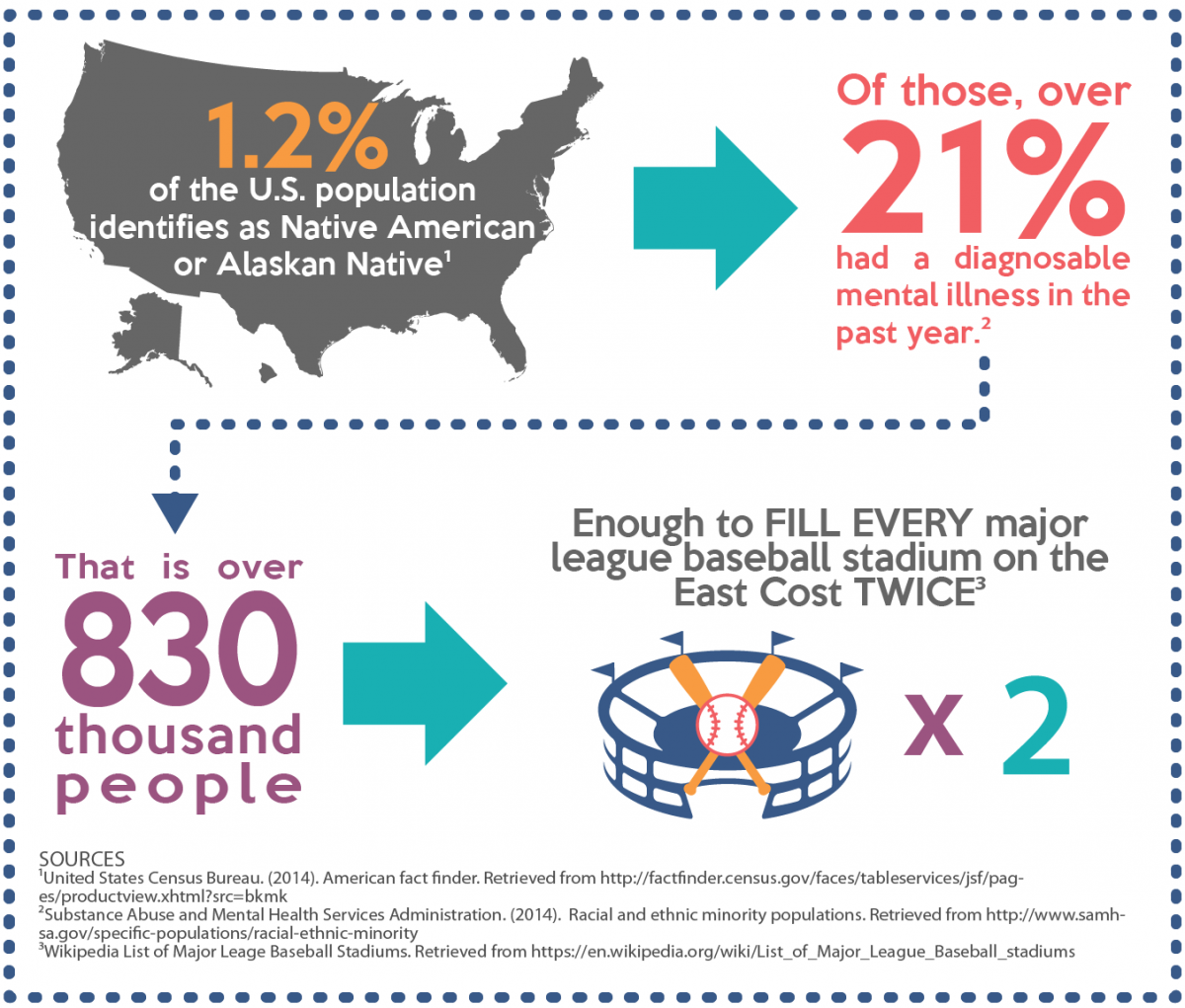You are here
Native American Communities and Mental Health
Mental Health America works nationally and locally to raise awareness about mental health and ensures that those at-risk for mental illnesses and related disorders receive proper, timely and effective treatment. MHA incorporates culturally competent strategies to ensure that it is effectively addressing the treatment and psychosocial needs of consumers and families with diverse values, beliefs, sexual orientations, and backgrounds that vary by race, ethnicity and/or language.
Statistics
Demographics/Societal Issues
- Approximately 1.2% of the U.S. population, or roughly 4 million Americans, identify themselves as having Native American or Alaska Native heritage. [1]
- There are 566 federally recognized Native American tribes and Native Americans speak more than 200 indigenous languages. [2][3]
- Most Native Americans live in Western states. About two-thirds now live in urban, suburban, or rural non-reservation areas; about one-third live on reservations. [3]
- Native Americans have twice the rate of victimization than that of African Americans, and more than 2.5 times that of whites. [3]
- Compared to the total U.S. population, more than twice as many Native Americans live in poverty. In 2013, Native American men and women were nearly twice as likely as whites to be unemployed. [4]
Attitudes
- There have not been many studies about Native American attitudes regarding mental health and mental illness. There is a general Native American worldview that encompasses the notions of connectedness, reciprocity, balance and completeness that frames their views of health and well-being. Studying this experience may help lead to the rediscovery of the fundamental aspects of psychological and social well-being and the mechanisms for their maintenance.
Prevalence
- Native Americans experience serious psychological distress 1.5 times more than the general population. [3]
- Native Americans experience PTSD more than twice as often as the general population. [3]
- Although overall suicide rates are similar to those of whites, there are significant differences among certain age groups. Suicide is the second leading cause of death among 10-34 year olds; whereas, the suicide rate among Native Americans that are more than 75 years old is only one-third of the general population. [3]
- Native Americans use and abuse alcohol and other drugs at younger ages, and at higher rates, than all other ethnic groups. [3]
Treatment Issues
- The concept of mental illness and beliefs about why and how it develops have many different meanings and interpretations among Native Americans. Physical complaints and psychological concerns are not distinguished and Native Americans may express emotional distress in ways that are not consistent with standard diagnostic categories. [3]
- Native Americans appear to use alternative therapies at rates equal to or greater than whites. In fact, research has found that Native American men and women who meet the criteria for depression, anxiety, or substance abuse disorders are significantly more likely to seek help from a spiritual healer than from specialty or other medical sources. [3]
- Due to high levels of poverty, many Native Americans face economic barriers that prevent them from receiving treatment. [3]
- Lack of awareness about mental health issues and services can prevent Native Americans from receiving treatment. [3]
Access/Insurance
- Access to mental health services is severely limited by the rural, isolated location of many Native American communities. Additionally, access is limited because most clinics and hospitals of the Indian Health Service are located on reservations, yet the majority of Native Americans no longer reside on reservations. [3]
- Compared to whites, three times as many Native Americans lack health insurance – 33% compared to 11%. Approximately 57% of Native Americans rely on the Indian Health Service for care. [3]
Partnerships and Resources
- Indian Health Services, U.S. Department of Health and Human Services
- National Center for American Indian and Alaska Native Mental Health Research
Sources
(1) United States Census Bureau. (2014). Quick facts. Retrieved from https://www.census.gov/quickfacts/table/PST120215/00
(2) Bureau of Indian Affairs. (2016). Indian entities recognized and eligible to receive services from the United States Bureau of Indian Affairs. Federal Register, 81(19), 5019-5025 https://www.gpo.gov/fdsys/pkg/FR-2016-01-29/pdf/2016-01769.pdf
(3) American Psychiatric Association. (2010). Mental health disparities: American Indians and Alaska Natives. http://www.integration.samhsa.gov/workforce/mental_health_disparities_american_indian_and_alaskan_natives.pdf
(4) Austin, A. (2013). High unemployment means Native Americans are still waiting for an economic recovery. Economic Policy Institute. Retrieved from http://www.epi.org/publication/high-unemployment-means-native-americans/









this page